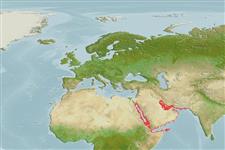Environment: milieu / climate zone / depth range / distribution range
Ecologia
marinhas associadas(os) a recifes; não migratória; intervalo de profundidade 4 - 55 m (Ref. 5222), usually 15 - 20 m (Ref. 89707). Tropical; 33°N - 10°N, 32°E - 66°E (Ref. 5222)
Western Indian Ocean: only from the northern end of the Red Sea to the Persian Gulf and coast of Pakistan. Records from elsewhere are apparently based on misidentifications of other species. Misidentified as Cephalopholis miniatus by Kuronuma & Abe (1986, Ref. 5999) from Kuwait.
Tamanho / Peso / Idade
Maturity: Lm ? range ? - ? cm
Max length : 35.0 cm TL macho/indeterminado; (Ref. 5222); common length : 23.0 cm TL macho/indeterminado; (Ref. 5450); idade máx. registrada: 26 anos (Ref. 1784)
Descrição suscinta
Chaves de identificação | Morfologia | Morfometria
Espinhos dorsais (total) : 9; Raios dorsais (total) : 8 - 10; Espinhos anais: 3; Raios anais : 8 - 10. distinguished by the following characteristics: body depth 2.7-3.0 in SL; head length 2.4-2.6 in SL; flat interorbital area; rounded preopercle, finely serrate, lower edge fleshy; distinctly convex upper edge of operculum; scaly maxilla, reaching to or somewhat beyond vertical at rear edge of eye; ctenoid body scales, without auxiliary scales (Ref. 089707).
In the Red Sea, it is often found on patchy open reef areas. Feeds diurnally on fishes (64%, mostly pomacentrids) and crustaceans (36%). It is a monogamous species, the pair jointly defends a common territory of up to 62 square m (Ref. 6480). Major threats include overfishing, lack of management and habitat loss (Ref. 089707).
Ciclo de vida ou comportamento de acasalamento
Maturidade | Reprodução | Desova | Ovos | Fecundidade | Larvas
Displays obligate monogamy where a one-to-one pair is established irrespective of resource abundance (Ref. 52884).
Heemstra, P.C. and J.E. Randall, 1993. FAO Species Catalogue. Vol. 16. Groupers of the world (family Serranidae, subfamily Epinephelinae). An annotated and illustrated catalogue of the grouper, rockcod, hind, coral grouper and lyretail species known to date. Rome: FAO. FAO Fish. Synop. 125(16):382 p. (Ref. 5222)
Status na Lista Vermelha da UICN (Ref. 130435: Version 2024-2)
Ameaça para os humanos
Harmless
Uso pelos humanos
Pescarias: pesca de subsistência
Ferramentas
Relatórios especiais
Baixar XML
Fontes da internet
Estimates based on models
Preferred temperature (Ref.
123201): 25.1 - 29.3, mean 27.3 °C (based on 46 cells).
Índice de diversidade filogenética (Ref.
82804): PD
50 = 0.5000 [Uniqueness, from 0.5 = low to 2.0 = high].
Bayesian length-weight: a=0.01259 (0.00587 - 0.02699), b=3.04 (2.87 - 3.21), in cm total length, based on LWR estimates for this Genus-body shape (Ref.
93245).
Nível Trófico (Ref.
69278): 4.1 ±0.6 se; based on diet studies.
Generation time: 10.0 ( na - na) years. Estimated as median ln(3)/K based on 1
growth studies.
Resiliência (Ref.
120179): Baixo, tempo mínimo de duplicação da população 4,5 - 14 anos (K=0.11).
Fishing Vulnerability (Ref.
59153): High vulnerability (58 of 100).
Climate Vulnerability (Ref.
125649): Very high vulnerability (88 of 100).
Nutrients (Ref.
124155): Calcium = 43.4 [24.0, 76.6] mg/100g; Iron = 0.5 [0.3, 1.0] mg/100g; Protein = 18.2 [16.4, 19.9] %; Omega3 = 0.154 [0.096, 0.249] g/100g; Selenium = 32.4 [17.4, 57.8] μg/100g; VitaminA = 237 [72, 838] μg/100g; Zinc = 0.929 [0.638, 1.466] mg/100g (wet weight);
